The following information on ballistic evidence and giving expert testimony comes from Section 35 of Shooting by J. Henry FitzGerald. Shooting is also available to purchase in print.
Valuable evidence is often destroyed by carelessness on the part of the investigator. Many things which ordinarily would be of no consequence are very important when found at the scene of a crime. An empty shell lying on the sidewalk or in a room would have no significance, but if the dead body of a man or woman was found a few feet away from the shell that shell would be very important as it might be traced to the pistol or revolver used.
Nearly every shell whether fired in a revolver or automatic pistol has identification marks which, if the arm used is found, will mark other shells in the same manner.
In the following pages are photomicrograph pictures by Captain William A. Jones, Firearms Expert and Expert Photographer of New York City, which will explain some of these identifications marks on shells and bullets.
Of utmost importance on finding a body, as mentioned above, is to disturb nothing until a thorough investigation has been made for finger prints, pistol, knife, revolver or other weapons, bullets, shells, position of body, and, if possible, photographs should be taken before anything is disturbed. No two cases are exactly alike and notes should be taken that can later be used in court of everything connected with the case. It does not necessarily mean because a body is found with a revolver or pistol grasped in the hand that it is a case of suicide. The weapon may have been placed under the hand by the murderer.
Powder stains, burns and scorches on clothing and body may determine whether the wound was self-inflicted or not. I remember a case on which I was called where an officer was killed with his service revolver. The officer was called to the house to subdue a drunken man. In the scuffle the policeman was shot. One bullet fired through the side of the coat near the bottom did no damage except to make four holes in the coat and sweater; the fatal bullet entered the body high up on the chest. Both bullets were fired from an angle that would make it impossible for the officer to fire either shot himself. This was a case where neither bullet, shell, nor revolver figured; only the position of bullet holes in body and clothing would be of assistance as far as firearms evidence was concerned. A conviction was secured.
Bullets found in the body or imbedded in any material at the scene of a crime are very important, as not only can the caliber, make, and weight be determined, but they can in nearly every case be traced to the revolver or pistol from which they were fired if the arm can be found. The land and groove marks on the bullets will in many cases determine the make of the arm used and will reveal the peculiarities of that particular arm.
I remember a case I was called on some years ago. The man who killed an officer rode a motorcycle and the arm used was a Colt New Service .45 caliber. He used an open holster open at the bottom and short enough to allow the muzzle of the revolver to extend below the leather. As he rode the muzzle would continually strike on the frame or guard of the motorcycle. This continual pounding caused the muzzle to be flattened in such a manner as to force a part of the steel at the muzzle inward until it extended beyond the surface of the barrel cavity. Every bullet fired through this barrel was marked in the same way with a very clear identification mark. Many cases are encountered where some peculiarity in the revolver or pistol in evidence may be noted and classed as a factory mark. We also have the identification marks which are caused by conditions over which the factory has no control, due to accidents, dropping and not cleaning properly. Corrosion or rust in the barrel may mark the bullet or any number of bullets in the same way. Erosion marks may be visible and traced to several bullets. A bullet stuck in the barrel and forced out by putting a piece of heavy wire or other steel instrument in the barrel at the muzzle may raise a furrow of steel at some point in the barrel that would mark every bullet exactly the same. I appeared in a case some years ago where this was the condition and it left a positive identification mark. Bullets may be classed as lead, metal cased, and soft point, and these all register the peculiarities of the particular arm through which it is fired.
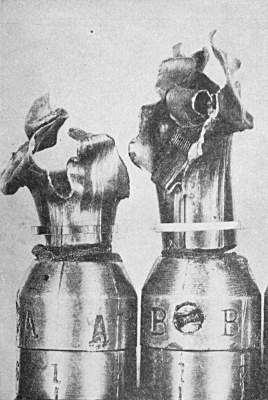
Great care must be taken in this work of matching bullets in evidence with bullets fired through the suspected revolver or pistol. It is not safe to jump at conclusions; be sure you are right and then go ahead. Only a careful examination with a good magnifying glass or microscope will reveal the facts to the expert, who possesses the ability through years of experiments and practice to compare the identification marks on bullets and shells fired from the same and different pistols and revolvers. Without this experience mistakes can be made with the microscope as well as with the magnifying glass. A seven-power glass is very accurate and as high as ten power in the magnifying glasses and ten to twenty-one power in the microscope is usually powerful enough for this work.
The question is many times asked me, would two barrels, coming one after the other from the rifling machine, carry identification marks by which the bullets could be traced to the barrels they were fired from? While two barrels may be rifled consecutively a slight difference may be found in the diameter of the lands and grooves. The bore diameter may vary one or two thousandths of an inch; the grooves may be deeper in one barrel than in the other; condition of the barrels after use may be such that the bullets may easily be checked as coming from one or the other barrel. A slight difference in the steel used in the barrels may cause a slight roughness in one that would not be found in the other. Two pistols or revolvers may be numbered consecutively, but that would not mean that the barrels were manufactured on the same machine or in rotation. Where mention is made in this article of defective tools or difference in grade of steel no particular make of arms are thought of, as both high-grade arms and those of inferior make and material are encountered in cases where firearms were used either to kill or wound, and the cheap, inferior arms of foreign manufacture are easier to trace a bullet to than the high-grade arms.
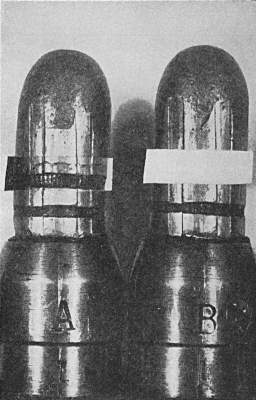
In a case which I had some years ago a man was killed with a .32 Smith & Wesson short bullet and the man who was arrested for the crime a short distance away was carrying a .32 Colt automatic pistol. The revolver shell was found near the body. It seemed a perfect alibi until the jury and court were shown that the .32 caliber Smith & Wesson short cartridge could be placed in the chamber of the .32 Colt automatic pistol and fired from it usually ejecting the empty shell, and allowing an automatic cartridge to be carried into the chamber and cocking the pistol. The bullet in this case could be traced to pistol in evidence and the shell plainly showed that it was not fired from a revolver.
It would be a long story to go into details of evidence encountered in thirty-five years of experimental work and then only a small part of what may be encountered in the gathering of evidence would be covered. We live and learn; we can only tell what we by experience know to be a fact and tell it in a way that it will be perfectly clear and understood by the court and jury. I believe that a very clear way to show identification marks on the bullets and shells is by the comparison microscope, as it shows clearly one-half of each two bullets compared and even persons not familiar with the work can easily see the identification marks or lines on lands and grooves if they exist. A complete outfit of high-priced microscopes are, of course, very helpful in expert work but equipment without experience means nothing. In a great many cases valuable evidence is lost by careless handling of the exhibits. One question: Why will an officer push a pencil or knife through a bullet hole in cloth, wood or other substance? I give it up, why will he?
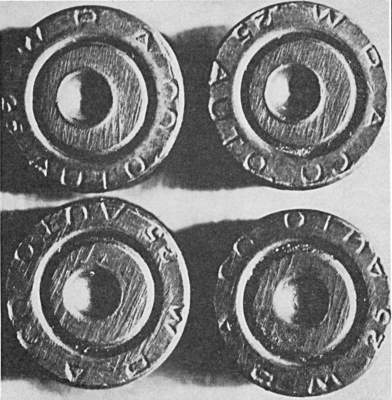
A very serious trouble in the identification of bullets is the difference in the diameter of each bullet even in the same box. This is overcome in revolver bullets, which are usually made of lead. A lead bullet will mold itself into the corners of the lands and grooves in the barrel where the metal-cased bullets are of harder material and will not always fill the corners of the grooves. Right and left hand twist and width of lands and groove will many times determine the make of revolver from which a certain bullet was shot. The primer will usually identify the pistol or revolvers from which it was fired.
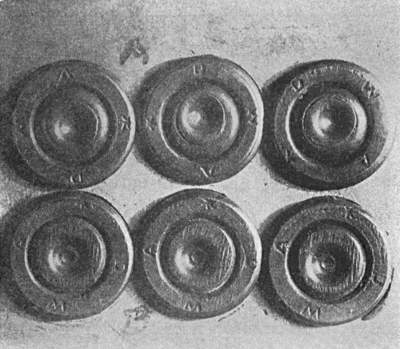
The firing pin identification is not always to be relied upon because of the kick back of the anvil in the primer, which will change the bottom of the firing pin indentation. In some automatic pistols the firing pin is the ejector and in this case the shell is rotating on the end of the firing pin from the instant the pistol starts to open until the shell is released. Many hard primers are encountered especially in the foreign cartridges and in these the lines and marks will not be so pronounced.
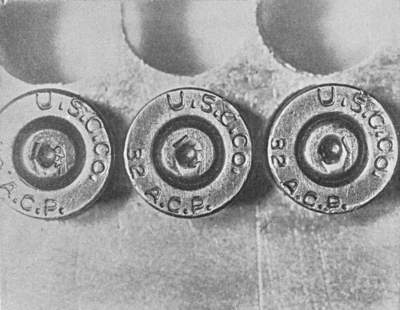
Many bullets recovered from a body and those which have come in contact with hard substances are deformed and some to the extent that only one or two lands and grooves are visible. If these happen to carry identification marks that can be traced to test bullets fired from the same revolver then fortune favors the expert. Sometimes identification is positive in a very few minutes and again several hours may be spent before a decision is reached. In any case the expert should be sure before rendering a decision.
My outfit consists of a Spencer Comparison Microscope; a Zeiss Binocular Microscope, with different objectives and eye pieces; a Zeiss Turmon Monocular, with 10X, 12X, 16X, and 20X supplementary lenses; a Hardy Binocular Loupe; a 10X Bausch & Lomb Hastings Triplet; a 7X of the same; an 8X and a 3OX Hensoldt Glass and an 8-power Zeiss Microscope.
Powder stains, scorches and burns on clothing or on the body are very important in connection with the bullet wound and may be classified as contact shots, near contact shots where powder stains, scorches or burns are found on the body or clothing, and the distance shots outside the zone of powder stains. The contact shot may be readily determined as, for instance, the revolver or pistol held against the side of the head as the shot is fired. If the muzzle is loosely pressed against the skin a large, ragged wound about the size of the muzzle of the pistol will be the result and the edge of the wound will appear to be forced outward. If the muzzle is held tightly against the skin the powder gases will follow the bullet into the wound a short ways and will cause a swelling around the wound about the size of a dollar and the edge of the wound will be ragged and forced outward. A contact shot shows a small burn or scorch on edge of wound. By using the same kind of a pistol or revolver and ammunition a very accurate estimate may be given of the distance between the muzzle and the wound, also the direction of the bullet in relation to the wound may be determined by the location of the wound and the powder stains or scorch on the body or clothing.
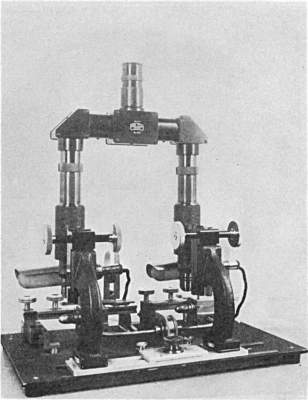
Many times the question arises as to how far away the shot can be fired and powder stains and burns appear on body or clothing? To answer this the kind of powder used must be known and also its condition, whether black or smokeless, whether the shooting was done in a strong wind, and, if so, whether against the wind or with it. Many conditions enter into the correct analysis of the evidence presented.
Bullet identification and other evidence brought out by expert testimony is positive and only doubted by those who do not understand it. I heard a man testify, in a case I was called in upon several years ago, that he could see the flash from a 6-inch .32/20 Colt revolver twenty-four inches long. When asked how far the powder would burn from the same arm he answered eighteen inches. He was then asked what burned to show the flash that last six inches and then he decided that three years’ experience as a gunsmith did not teach him all he should know.
Great stress has been laid on the fact that experts disagree, so do doctors and professional men and people in all walks of life. It lays with the judge and jury to determine the honesty of a witness, whether he be an expert or just a witness, and a disagreement of experts does not mean in all cases that one of them is dishonest; experience and judgment may enter into the case. We can only testify to what we can see.
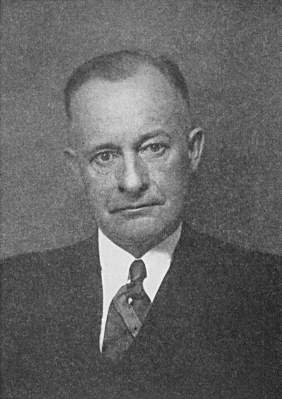
Many more interesting facts might be added to this section if we were sure that the book would only reach the hands of those who would use them for lawful purposes. The fascinating part of expert testimony is that no two cases are the same. In consultations and testimony relating to hundreds of cases I have found this true; such aids as trick photographs and manufactured evidence is never resorted to by the honest expert. He has no interest in the poor devil being tried; he is only interested in his work and the stating of plain facts as he sees them.
Capt. William A. Jones, Mr. Albert W. Foster, Jr., and myself have appeared in many cases and examined hundreds of bullets and firearms together. I cannot recall one case where we have disagreed in our diagnosis of a case.
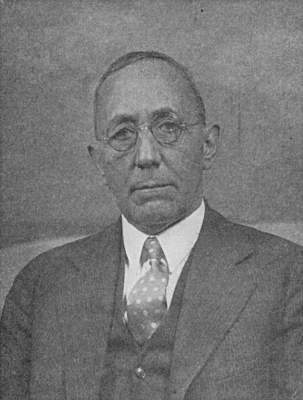
I have appeared at different times with Capt. Van Amberg, Boston, Mass., James Burns, Ballistic Engineer, Remington Arms Co., and Murton Robinson, Winchester Repeating Arms Co.,—men with years of experience and a thorough understanding of the value of bullet identification.
